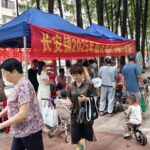1/4
On the morning of August 14th, the early autumn sea of clouds graced the areas of Pingshan Town and Magu Town in Hezhang County, Bijie City, Guizhou Province. The mountain villages were veiled in drifting mist, resembling an unfolding ink-wash landscape painting.
Pingshan Town
Pingshan Town, located in Shenzhen, Guangdong Province, China, is a historic area known for its cultural heritage and traditional Hakka architecture. It was established during the Ming and Qing dynasties and is home to landmarks like the Pingshan Ancient Temple and well-preserved Hakka walled villages. Today, it blends historical charm with modern development as part of Shenzhen’s rapid urbanization.
Magu Town
Magu Town is a historic and culturally rich area located in China’s Sichuan Province, known for its well-preserved ancient architecture and traditional tea culture. With a history dating back over a thousand years, it was an important stop along the ancient Tea Horse Road, facilitating trade between China and Tibet. Today, it attracts visitors with its charming old streets, tea plantations, and cultural heritage.
Hezhang County
Hezhang County, located in Guizhou Province, China, is known for its rich cultural heritage and stunning natural landscapes, including karst formations and lush valleys. Historically, it has been home to diverse ethnic groups, such as the Yi and Miao people, who preserve traditional customs and festivals. The area also gained attention for the discovery of ancient rock fossils, contributing to its significance in paleontological research.
Bijie City
Bijie City, located in Guizhou Province, China, is a prefecture-level city known for its stunning natural landscapes, including the Zhijin Cave and the Baili Azalea Scenic Area. Historically, it was an important region for the Yi and Miao ethnic minorities and played a role in the Red Army’s Long March during the 1930s. Today, Bijie is recognized for its cultural diversity, eco-tourism, and efforts in poverty alleviation.
Guizhou Province
Guizhou Province, located in southwestern China, is known for its stunning karst landscapes, lush mountains, and rich ethnic diversity, home to Miao, Dong, and other minority groups. Historically, it was a remote region during imperial times but became strategically important during World War II as a refuge for government and academic institutions. Today, it is celebrated for its traditional villages, vibrant festivals, and UNESCO-listed sites like the Libo Karst and Honghe Hani Rice Terraces.





